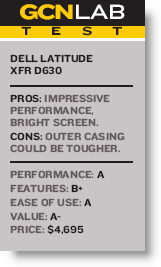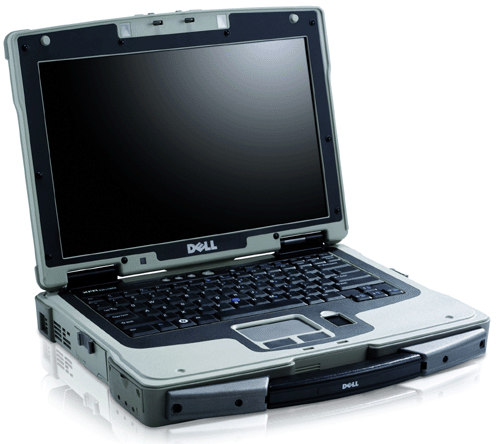In Philosophy 101, I learned about what philosophers call the mind/body problem, which is the dualist division between the body and the brain. The Dell Latitude XFR D630, the company's first fully ruggedized notebook PC, has a mind/body problem of its own. Its mind ' the computer processing part of the XFR D630 ' is a beauty. It got high benchmark scores in just about every area. This is a rugged notebook with Ivy League smarts, and it held up well to most of the pressure-cooker tests we threw at it.But its body ' the shell that houses that beautiful mind of a processor ' could be tougher. Its rugged good looks didn't hold up as well as we had hoped under the Mil- Std 810F drop tests we administered. Dell went with a plastic-like polymer for the case, which made the notebook lighter than we expected but not quite as tough. The notebook didn't fail in any of our tests of its ruggedness, but in places where the plastic met metal components, such as at the top of the locking mechanism, the harder metal began to dig into the softer materials during the shock tests.The first thing the GCN Lab team noticed when we unpacked the XFR D630 was its cool retro style. With an easy-to-carry handle and subdued earth tones of desert tan, it looked like a portable record player circa 1969, the kind I used to play Partridge Family 45s on in fifth grade. But this Dell is no bubblegum one-hit wonder. It packs its desktop power into a package that weighs a little less than 9 pounds. It runs on Intel Core 2 Duo processors and has optional solid-state drives.When we tested performance using the Performance Test 6.1 benchmark suite from PassMark Software, the XFR D630 earned a 539.7 score, compared with the 497 scored by the Acer TravelMate 6292, an ultraportable notebook that was a recent GCN Lab Reviewer's Choice (GCN.com/1157). Along with packing a lot of power, the XFR D630 also has a bright 14.1- inch LCD screen with DirectVue enhancements for optimal sunlight readability. This is important because users might often be viewing the screen outdoors. All the plugs, ports and hinges have covers that keep out dust, moisture, and salt fog and spray, which means the laptop would travel well on a ship.The XFR D630 comes with all the features a military or government user of ruggedized notebook PCs would expect: a stylus integrated with a tether, a biometric fingerprint reader, a sealed touchpad and mouse buttons. The XFR D630 also comes with an array of wireless features, including an internal Wi-Fi 802.11 wireless local-area network PCI Express mini card and Dell Wireless 1395 802.11g, 1490 802.11a/g or 1505 Draft 802.11n Wi-Fi card.The XFR D630 uses the same components as Dell's existing Latitude line, so users can swap AC adapters, batteries and docking stations with the Latitude laptop PCs they already own. We tested the battery life by looping a short video at 80 percent screen brightness. The lithium ion battery lasted a respectable 2 hours, 46 minutes. And of course, this was a worst-case scenario. Your mileage with normal use should be a lot better.The XFR D630 also meets Mil-Std 810F for temperature extremes, moisture, dust, drops, shock, salt fog, vibration and altitude. The unit passed GCN Lab's tests for heat and humidity and, in fact, worked slightly better after the testing than before. So if your summer plans include a trip to a swamp or Washington, D.C., in August, this is the rugged notebook for you. The XFR D630 uses what Dell calls a QuadCool thermal management system, and it did a great job of keeping the unit cool under pressure.We ran the XFR D630 for an hour and a half in an environment that was 120 degrees Fahrenheit with 98 percent humidity, and it worked just fine. This was after we had subjected it to rigorous drop tests. We evaluated the unit against the PassMark benchmarks again after the rainforest test, and this time it scored 548.9 ' more than nine points higher. It was as if all the bouncing and humidity caused the laptop to right itself and perform even better.But the XFR D630 showed some weaknesses in our drop tests, which comply with Mil-Std 810F guidelines. It passed, but I can't say it did so with flying colors.We dropped the Latitude onto a full two inches of plywood over concrete on its front, back, four sides and eight corners at heights of 12 inches, 24 inches and 36 inches. At 12 inches, everything worked properly. The screen was still a vivid Windows XP blue, although the XFR D630 is designed to optimize Windows Vista, Dell representatives said.At 24 inches, the battery disconnected from the unit for an instant, and the XFR D630 went dead for a few seconds, as though it was having a little seizure. We couldn't resuscitate the machine without rebooting it. Then it was fine and functioned as though nothing had happened.When we dropped the XFR D630 on its back from 36 inches, the battery disconnected again, the screen went black, and we had to reboot it. This time, part of the metal clips in the top closure ' what the product guide calls the reinforced zinc latching system ' went a bit out of kilter, so it was hard to open and close the notebook. And now that they were askew, the metal clips dug into the plastic of the casing ' what the product literature calls shock-absorbing thermo-elastomer composite overmold material ' when we closed the top. This created a dust of plastic shavings that clung to the keyboard and screen. Eventually, the latch will fail, given that the hooks were eating away at their holes, although our testing ended long before this could occur.The battery detached for a third time on a corner drop from 36 inches. We rebooted, and it functioned as though nothing had gone wrong. I wish people were as resilient.Dell's first foray into the world of ruggedized notebook PCs is selling for $4,695, with discounts available for government customers. The company has packed plenty of performance into the XFR D630, but its rugged features need some tweaking. That could just be a matter of strengthening some of the outer casing materials. But toughen up it must.Dell representatives said the XFR D630 can withstand salt fog and spray, making it a good choice for sailors. I just wouldn't want to be a sailor in the middle of a mission-critical task when the battery detaches or I can't get the top open.[IMGCAP(1)]
 Dell Inc., 800-999-3355, www.dell.com/latitude
Dell Inc., 800-999-3355, www.dell.com/latitude








